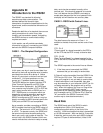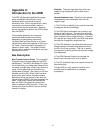
42
Resistive Coupling (or 'Ground Loops').
Currents through common connections can give
rise to noise voltages.
Resistive Coupling
Here, the detector is measuring the voltage
across the experiment, plus the voltage due to
the noise current passing through the finite
resistance of the ground bus. This problem
arises because we have used two different
grounding points which are not at exactly the
same potential. Some cures for ground loop
problems include:
1) grounding everything to the same physical
point,
2) using a heavier ground bus to reduce the
potential drop along the ground bus,
3) removing sources of large currents from
ground wires used for small signals.
Microphonics provides a path for mechanical noise
to appear as electrical noise in a circuit or
experiment. Consider the simple circuit below:
The capacitance of a coaxial cable is a function of its
geometry so mechanical vibrations will cause the
cable capacitance to vary with time. Since C=Q/V,
we have
C dV + V dC
= dQ = i
dt dt dt
so mechanical vibrations will cause a dC/dt which in
turn gives rise to a current i, which will affect the
detector. Ways to eliminate microphonic signals
include:
1) eliminate mechanical vibrations,
2) tie down experimental cables so they will not
sway to and fro,
3) use a low noise cable that is designed to reduce
microphonic effects.
Thermocouple Effect. The emf created by dissimilar
metal junctions can give rise to many microvolts of
dc potential, and can be a source of ac noise if the
temperature of the junction is not held constant.
This effect is large on the scale of many low level
measurements.


















